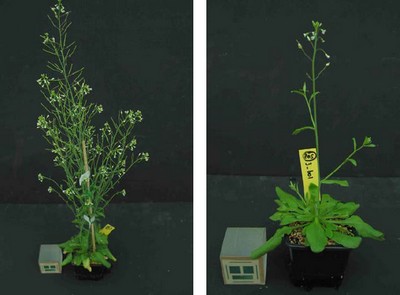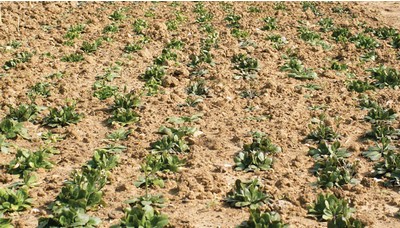Revolution in plant genetics
It is not just changes in the DNA sequence that determine complex heritable traits. Scientists from the University of Groningen Bioinformatics Centre (GBIC), together with their French colleagues, have shown that epigenetic marks can affect traits like flowering time and plant architecture in plants. These marks are attached to the DNA, but do not affect the gene sequence. The new study shows that these marks are passed on for many generations in a stable manner. It seems that a revision of Genetics textbooks is now needed.

It’s what they teach in every basic Biology class: DNA is the physical basis of heredity. The DNA is made up of four different nucleotides, represented by the letters A, T, C and G. These letters spell out the genetic code and changes in this code (like an A being replaced by a C), called mutations, can change the function of our genes.
But in a paper that appeared on Thursday 6 February on the fast track online publication service of the journal Science, called Science Express, Frank Johannes and his colleagues announce a revolution in thinking about heredity – at least in plants. They show that plants with identical DNA sequences can differ in hereditary traits like flowering time or plant architecture.
Johannes and his group focus on epigenetic marks. It has been known for a long time that such marks can silence genes. For example, a cytosine nucleotide (the C in the genetic code) can be changed into a methylcytosine. This methylation represents an epigenetic mark and it will repress the activity of the gene of which the methylated C is a part.
Such epigenetic marks are placed for different reasons, for example during development, or as a result of environmental factors. ‘While in mammals epigenetic marks are typically reset every generation, in plants no such dramatic resetting takes place. This opens the door to epigenetic inheritance in plants: epigenetic changes that are acquired in one generation tend to be stably passed on to the next generation’, explains Frank Johannes, assistant professor at the GBIC (now GBB) and co-lead scientist for the Science Express study.

Johannes’s French colleagues have produced inbred strains of the model plant Arabidopsis, in which the epigenetic marks vary between strains while the DNA sequence is almost identical. Nevertheless, these strains show marked differences in appearance, which are passed on to later generations.
n the new study, Johannes and his French colleagues have successfully linked variation in epigenetic marks to complex traits like flowering time and plant architecture in these Arabidopsis strains. They employed techniques that are typically used by geneticists to locate the DNA regions with sequence variations that contribute to complex traits. These are called quantitative trait loci or QTLs.
Johannes: ‘We used the same method to locate regions in the DNA, not with different sequences but with different epigenetic marks that contribute to certain traits in the plant.’ It is the first time that epigenetic differences have been unequivocally shown to contribute to heritable traits. ‘This is a breakthrough, because it changes the way we view genetics. And it may even be of huge economic importance.’

In the new study, Johannes and his French colleagues have successfully linked variation in epigenetic marks to complex traits like flowering time and plant architecture in these Arabidopsis strains. They employed techniques that are typically used by geneticists to locate the DNA regions with sequence variations that contribute to complex traits. These are called quantitative trait loci or QTLs.
Johannes: ‘We used the same method to locate regions in the DNA, not with different sequences but with different epigenetic marks that contribute to certain traits in the plant.’ It is the first time that epigenetic differences have been unequivocally shown to contribute to heritable traits. ‘This is a breakthrough, because it changes the way we view genetics. And it may even be of huge economic importance.’
Although the Science Express paper is based on heritability over just seven generations, other results with the Arabidopsis strains show that epigenetic traits are stably inherited for at least 20 generations. Johannes: ‘Such stable traits can be of interest to plant breeders. Apart from variations in the gene sequence, epigenetic variation may contribute to commercially interesting traits.’ The new findings were made with inbred strains. ‘But we also have evidence that we can find some of the same epigenetic QTLs in wild populations of this species as well.’ This suggests it is not just a laboratory artefact but something that plays a role in nature.
The epigenetic marks may also affect evolution, independent of DNA sequence. ‘They cause variation on which natural selection can act’, Johannes explains. As such, traits caused by epigenetic variation may make an independent contribution to changes in a species. But although the method of inheritance is different, it makes no difference for the (mathematical) models describing evolution. ‘Those models were developed in the 1950s, when we knew very little about the physical basis of heredity.’
While educators are busy rewriting their Plant Genetics textbooks, Johannes and his team are trying to zoom in on the epigenetic marks. A QTL points to a fairly long stretch of DNA that might have 500,000 to one million ‘DNA letters’ (or base pairs). ‘We want to know in more detail where the marks are placed.’ This might also help in understanding what mode of action these marks have.
| Last modified: | 03 March 2017 2.12 p.m. |
More news
-
29 April 2024
Tactile sensors
Every two weeks, UG Makers puts the spotlight on a researcher who has created something tangible, ranging from homemade measuring equipment for academic research to small or larger products that can change our daily lives. That is how UG...
-
16 April 2024
UG signs Barcelona Declaration on Open Research Information
In a significant stride toward advancing responsible research assessment and open science, the University of Groningen has officially signed the Barcelona Declaration on Open Research Information.
-
02 April 2024
Flying on wood dust
Every two weeks, UG Makers puts the spotlight on a researcher who has created something tangible, ranging from homemade measuring equipment for academic research to small or larger products that can change our daily lives. That is how UG...

